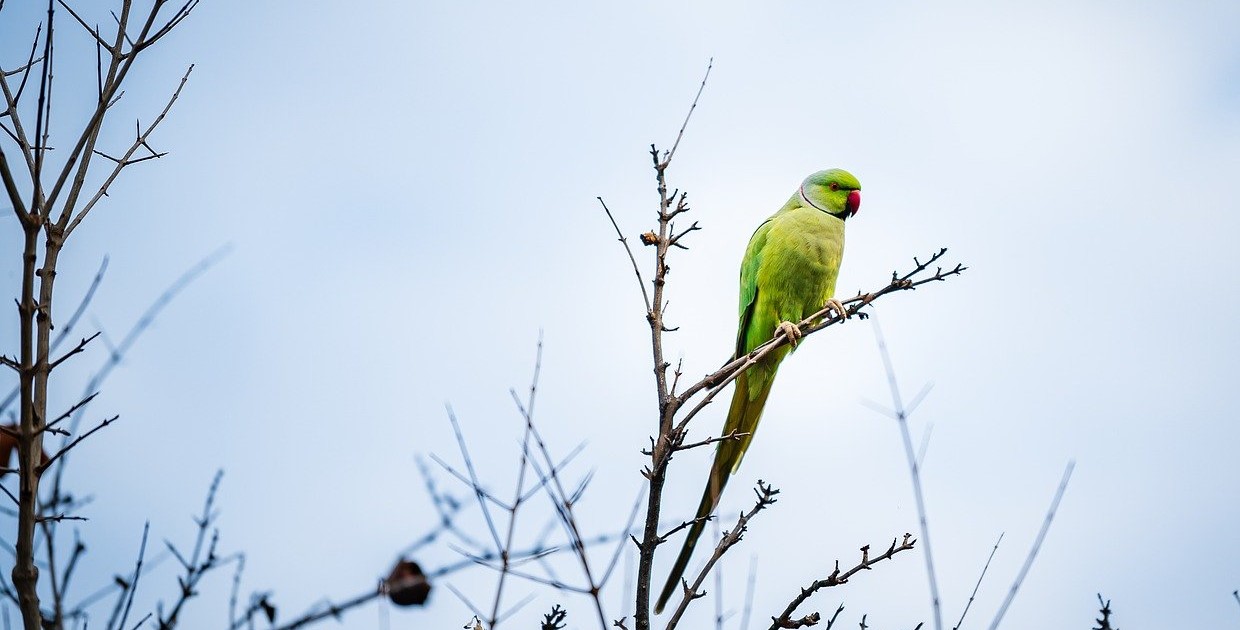Lost Bird – Tips for a Successful Reunion

Content shared with permission of 911 Parrot Alert.
Your pet bird is lost, what do you do? It’s important to remain calm and begin your search right away. Here are some tips to get you started.
CONDUCT A PHYSICAL SEARCH
Search on foot or on a bicycle in concentric circles from the point where you saw your bird fly off or from the last location your bird was seen. If you saw your bird leave, keep the direction of flight in mind.
Your bird is most likely within one-half to two miles or closer, probably much closer. Look in EVERY BUSH, EVERY TREE, every nook and cranny of structures in the area. Look on the ground, in bushes, on branches of trees high and low, as many birds are found in low-lying areas, too.
The best time for additional searches is just before or at sunrise and later in the day around sunset when birds are most vocal. The first 48 hours are critical in searching for your bird.
USE SIGNS AND FLYERS TO SPREAD THE WORD
Post large, brightly colored signs with your bird’s picture and your phone number. Create flyers and go door to door in the neighborhood. You can create a free flyer when you enter a report at PetFBI.org. Get the word out to:
- Neighbors and neighborhood children
- Gardeners and HOA or apartment maintenance workers
- Postal Carriers, UPS drivers, phone repair/cable installers, highway workers, trash collectors and any other municipal workers in the area
- Avian veterinarians
- Local police/sheriff departments and animal control
- Local animal rescue groups
- Parks & Rec Departments and golf courses
- Visit animal shelters in person
USE SOCIAL MEDIA AND THE INTERNET
Enter a report in our database and at 911 Parrot Alert. Also post on Nextdoor.com, the lost and found section of Craigslist, neighborhood Facebook pages, bird owner Facebook Groups, and other lost and found social media sites.
BRING YOUR BIRD’S ENCLOSURE OUTSIDE
If possible, bring your bird’s enclosure outside in a safe, secure place and put lots of food and water inside with the door open. Birds who are more flight- skilled have been known to make their way back home and land on their enclosure. If bringing your bird’s main enclosure outdoors is impossible, you can also bring play stands outside and/or smaller carriers with food and water available.
BROADCAST YOUR BIRD’S VOCALIZATIONS
Broadcasting your bird’s vocalizations from your phone can elicit bird responses. There are websites where you can download bird species-specific vocalizations and then play them. Search [your bird species] and “vocalizations.”
WHEN YOU FIND YOUR BIRD
You’ve located your bird, now what? STAY CALM. Speak and move calmly to your bird so as to keep him/her CALM, as well.
If your bird is up in a tree or on a structure, your bird may very well fly to you. Try to entice your bird with food. If he/she takes flight, your bird may circle around a few times and land on a lower spot. Try to get yourself as high as is safely possible.
If your bird is VERY high up in a tree, be patient. It will likely be a waiting game until your bird decides to move. If possible, bring an enclosure or play stand with food and water. Be patient.
If your bird is skittish, set up a feeding station with the bird’s enclosure or carrier where the bird presently is or was last positively sighted. Set the enclosure/carrier as high as is physically and safely possible. Put a little food and water on top of the enclosure/carrier and lots more food and water inside the enclosure/carrier toward the back. Obtain fishing line and tie one end to the door of the enclosure/carrier, and the other end, several feet away, being held by a person. Allow the bird to get to the enclosure and move inside for the additional food. When safely inside, swiftly pull on the fishing line to close the door.
CAUTION: Unless there is an extreme emergency of a severe weather event, fire, or other time critical urgency, please DO NOT call a tree trimmer or some such service due to spooking your bird and risk losing him/her again. Resist the urge to spray them with water or to throw things in an effort to get them to move. If you startle them into flying, they could fly further away than they would if they were to move of their own accord.
Thank you to 911 Parrot Alert for sharing their valuable advice. You can download their complete Search & Retrieve Protocol here. Check out their website for more lost and found bird advice.